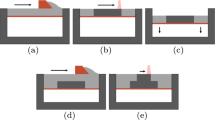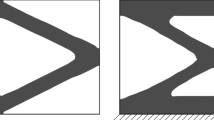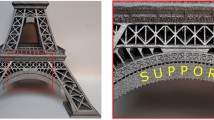Abstract
This paper presents a topology optimization algorithm to deal with elastoplastic and layer-by-layer simulation for the additive manufacturing process. The objective of the optimization problem is to minimize the P-norm stress or the displacement in the build direction by modifying the design variable in the support domain in order to prevent build failures or large deformations. The elastoplastic model follows an elastic predictor plastic corrector algorithm under the assumption of small deformation with the von mises criterion and bilinear hardening. The topology optimization is density based and the gradient of the objective function is obtained with the adjoint method. Both forward and adjoint problems are solved with the finite element method with a matrix-free approach on Graphics Processing Unit (GPU). The numerical cases include a verification of the mechanical problem against Ansys, a verification of the sensitivity analysis with a finite difference comparison and the calculation of optimized support designs for two geometries: a rectangular block and a bracket for a more complex part. The influence of several parameters are investigated: the number of layers in the simulation, the effect of plasticity, the use of different objective functions and of different mesh sizes.






























Similar content being viewed by others
References
Aage N, Lazarov BS (2013) Parallel framework for topology optimization using the method of moving asymptotes. Struct Multidisc Optim 47(4):493–505. https://doi.org/10.1007/s00158-012-0869-2
Alberdi R, Zhang G, Li L, Khandelwal K (2018) A unified framework for nonlinear path-dependent sensitivity analysis in topology optimization. Int J Numer Methods Eng 115(1):1–56. https://doi.org/10.1002/nme.5794
Allaire G, Bihr M, Bogosel B (2020) Support optimization in additive manufacturing for geometric and thermo-mechanical constraints. Struct Multidisc Optim 61(6):2377–2399. https://doi.org/10.1007/s00158-020-02551-1
Bartsch K, Lange F, Gralow M, Emmelmann C (2019) Novel approach to optimized support structures in laser beam melting by combining process simulation with topology optimization. J Laser Appl 31(2):022302. https://doi.org/10.2351/1.5096096
Bogomolny M, Amir O (2012) Conceptual design of reinforced concrete structures using topology optimization with elastoplastic material modeling. Int J Numer Methods Eng 90(13):1578–1597. https://doi.org/10.1002/nme.4253
Carey GF, Jiang B-N (1986) Element-by-element linear and nonlinear solution schemes. Commun Appl Numer Methods 2(2):145–153. https://doi.org/10.1002/cnm.1630020205
Čermák M, Sysala S, Valdman J (2019) Efficient and flexible MATLAB implementation of 2D and 3D elastoplastic problems. Appl Math Comput 355:595–614. https://doi.org/10.1016/j.amc.2019.02.054
Chen Q, Liang X, Hayduke D, Liu J, Cheng L, Oskin J, Whitmore R, Albert CT (2019) An inherent strain based multiscale modeling framework for simulating part-scale residual deformation for direct metal laser sintering. Addit Manuf 28:406–418. https://doi.org/10.1016/j.addma.2019.05.021
Cheng L, To A (2019) Part-scale build orientation optimization for minimizing residual stress and support volume for metal additive manufacturing: Theory and experimental validation. Comput Aided Des 113:1–23. https://doi.org/10.1016/j.cad.2019.03.004
Cheng L, Liang X, Bai J, Chen Q, Lemon J, To A (2019) On utilizing topology optimization to design support structure to prevent residual stress induced build failure in laser powder bed metal additive manufacturing. Addit Manuf 27(March):290–304. https://doi.org/10.1016/j.addma.2019.03.001
Denlinger ER, Gouge M, Irwin J, Michaleris P (2017) Thermomechanical model development and in situ experimental validation of the laser powder-bed fusion process. Addit Manuf 16:73–80. https://doi.org/10.1016/j.addma.2017.05.001
Jeet D, Grégoire A, François J, Chetra M (2021) Topology optimization in quasi-static plasticity with hardening using a level-set method. Struct Multidisc Optim. https://doi.org/10.1007/s00158-021-03034-7
Dong W, Liang X, Chen Q, Hinnebusch S, Zhou Z, To AC (2021) A new procedure for implementing the modified inherent strain method with improved accuracy in predicting both residual stress and deformation for laser powder bed fusion. Addit Manuf 47:102345. https://doi.org/10.1016/j.addma.2021.102345
Dugast F, Apostolou P, Fernandez A, Dong W, Chen Q, Strayer S, Wicker R, To AC (2021) Part-scale thermal process modeling for laser powder bed fusion with matrix-free method and GPU computing. Addit Manuf 37(October 2020):101732. https://doi.org/10.1016/j.addma.2020.101732
Francois MM, Sun A, King WE, Henson NJ, Tourret D, Bronkhorst CA, Carlson NN, Newman CK, Haut T, Bakosi J, Gibbs JW, Livescu V, Vander Wiel SA, Clarke AJ, Schraad MW, Blacker T, Lim H, Rodgers T, Owen S, Abdeljawad F, Madison J, Anderson AT, Fattebert JL, Ferencz RM, Hodge NE, Khairallah SA, Walton O (2017) Modeling of additive manufacturing processes for metals: Challenges and opportunities. Curr Opin Solid State Mater Sci 21(4):198–206. https://doi.org/10.1016/j.cossms.2016.12.001
Gaynor AT, Guest JK (2016) Topology optimization considering overhang constraints: eliminating sacrificial support material in additive manufacturing through design. Struct Multidisc Optim 54(5):1157–1172. https://doi.org/10.1007/s00158-016-1551-x
Guo X, Zhou J, Zhang W, Du Z, Liu C, Liu Y (2017) Self-supporting structure design in additive manufacturing through explicit topology optimization. Comput Methods Appl Mech Eng 323:27–63. https://doi.org/10.1016/j.cma.2017.05.003
Holmberg E, Torstenfelt B, Klarbring A (2013) Stress constrained topology optimization. Struct Multidisc Optim 48(1):33–47. https://doi.org/10.1007/s00158-012-0880-7
Jung D, Gea HC (2004) Topology optimization of nonlinear structures. Finite Elements in Analysis and Design 40(11):1417–1427. https://doi.org/10.1016/j.finel.2003.08.011
Kiss I, Gyimóthy S, Badics Z, Pávo J (2012) Parallel realization of the element-by-element FEM technique by CUDA. IEEE Transactions on Magnetics 48(2):507–510. https://doi.org/10.1109/TMAG.2011.2175905
Liang X, Cheng L, Chen Q, Yang Q, To AC (2018) A modified method for estimating inherent strains from detailed process simulation for fast residual distortion prediction of single-walled structures fabricated by directed energy deposition. Addit Manuf 23(July):471–486. https://doi.org/10.1016/j.addma.2018.08.029
Lindgren LE, Runnemalm H, Näsström MO (1999) Simulation of multipass welding of a thick plate. Int J Numer Methods Eng 44(9):1301–1316. https://doi.org/10.1002/(SICI)1097-0207(19990330)44:9<1301::AID-NME479>3.0.CO;2-K
Lu X, Chiumenti M, Cervera M, Li J, Lin X, Ma L, Zhang G, Liang E (2021) Substrate design to minimize residual stresses in Directed Energy Deposition AM processes. Mater Des 202:109525. https://doi.org/10.1016/j.matdes.2021.109525
Markl M, Körner C (2016) Multiscale modeling of powder bed-based additive manufacturing. Annu Rev Mater Res 46(1):93–123. https://doi.org/10.1146/annurev-matsci-070115-032158
Maute K, Ramm E (1997) Adaptive topology optimization of shell structures. AIAA J 35(11):1767–1773. https://doi.org/10.2514/2.25
McConaha M, Venugopal V, Anand S (2021) Design tool for topology optimization of self supporting variable density lattice structures for additive manufacturing. J Manuf Sci Eng Trans ASME. https://doi.org/10.1115/1.4049507
Michaleris P, Tortorelli DA, Vidal CA (1994) Tangent operators and design sensitivity formulations for transient non-linear coupled problems with applications to elastoplasticity. Int J Numer Methods Eng 37(14):2471–2499. https://doi.org/10.1002/nme.1620371408
Miki T, Takayuki Y (2021) Topology optimization considering the distortion in additive manufacturing. Finite Elements Anal Des 193(2020):103558. https://doi.org/10.1016/j.finel.2021.103558
Mirzendehdel AM, Suresh K (2016) Support structure constrained topology optimization for additive manufacturing. CAD Comput Aid Des 81:1–13. https://doi.org/10.1016/j.cad.2016.08.006
Misiun G, van de Ven E, Langelaar M, Geijselaers H, van Keulen F, van den Boogaard T, Ayas C (2021) Topology optimization for additive manufacturing with distortion constraints. Comput Methods Appl Mech Eng 386:114095. https://doi.org/10.1016/j.cma.2021.114095
Pellens J, Lombaert G, Michiels M, Craeghs T, Schevenels M (2020) Topology optimization of support structure layout in metal-based additive manufacturing accounting for thermal deformations. Struct Multidisc Optim 61(6):2291–2303. https://doi.org/10.1007/s00158-020-02512-8
Prabhune BC, Suresh K (2020) A fast matrix-free elasto-plastic solver for predicting residual stresses in additive manufacturing. CAD Comput Aid Des 123:102829. https://doi.org/10.1016/j.cad.2020.102829
Russ JB, Waisman H (2021) A novel elastoplastic topology optimization formulation for enhanced failure resistance via local ductile failure constraints and linear buckling analysis. Comput Methods Appl Mech Eng 373:113478. https://doi.org/10.1016/j.cma.2020.113478
Sigmund O (2001) A 99 line topology optimization code written in Matlab. Struct Multidisc Optim 21(2):120–127. https://doi.org/10.1007/s001580050176
Sigmund O, Maute K (2013) Topology optimization approaches. Struct Multidisc Optim 48:1031–1055. https://doi.org/10.1007/s00158-013-0978-6
Subedi SC, Shahba A, Thevamaran M, Thoma DJ, Suresh K (2022) Towards the optimal design of support structures for laser powder bed fusion-based metal additive manufacturing via thermal equivalent static loads. Addit Manuf 57(May):102956. https://doi.org/10.1016/j.addma.2022.102956
Svanberg K (1987) The method of moving asymptotes–a new method for structural optimization. Int J Numer Methods Eng 24:359–373. https://doi.org/10.1002/nme.1620240207
Swan CC, Kosaka I (1997) Voigt-Reuss topology optimization for structures with nonlinear material behaviors. Int J Numer Methods Eng 40(20):3785–3814. https://doi.org/10.1002/(SICI)1097-0207(19971030)40:20<3785::AID-NME240>3.0.CO;2-V
Takezawa A, To AC, Chen Q, Liang X, Dugast F, Zhang X, Kitamura M (2020) Sensitivity analysis and lattice density optimization for sequential inherent strain method used in additive manufacturing process. Comput Methods Appl Mech Eng 370:113231. https://doi.org/10.1016/j.cma.2020.113231
van Dijk NP, Maute K, Langelaar M, van Keulen F (2013) Level-set methods for structural topology optimization: a review. Struct Multidisc Optim 48(3):437–472. https://doi.org/10.1007/s00158-013-0912-y
Wang C, Qian X (2020) Simultaneous optimization of build orientation and topology for additive manufacturing. Addit Manuf 34(2019):101246. https://doi.org/10.1016/j.addma.2020.101246
Xu S, Liu J, Ma Y (2022) Residual stress constrained self-support topology optimization for metal additive manufacturing. Comput Methods Appl Mech Eng 389:114380. https://doi.org/10.1016/j.cma.2021.114380
Zhang ZD, Ibhadode O, Ali U, Dibia CF, Rahnama P, Bonakdar A, Toyserkani E (2020) Topology optimization parallel-computing framework based on the inherent strain method for support structure design in laser powder-bed fusion additive manufacturing. Int J Mech Mater Des 16(4):897–923. https://doi.org/10.1007/s10999-020-09494-x
Zhou M, Liu Y, Lin Z (2019) Topology optimization of thermal conductive support structures for laser additive manufacturing. Comput Methods Appl Mech Eng 353:24–43. https://doi.org/10.1016/j.cma.2019.03.054
Acknowledgements
The financial support from the NASA University Leadership Initiative (ULI) program is gratefully acknowledged.
Author information
Authors and Affiliations
Corresponding author
Ethics declarations
Conflict of interest
The authors declare no conflicts of interest
Replication of results
The STL files for the numerical cases are given as additional data. The voxelisation is done in Matlab based on this code: Adam A (2022). Mesh voxelisation (https://www.mathworks.com/matlabcentral/fileexchange/27390-mesh-voxelisation), MATLAB Central File Exchange. Retrieved September 4, 2022. The implementation of the forward problem follows the modeling approach (linear shape function, voxel mesh, Newton’s method, elastic predictor–plastic corrector) of Čermák et al. (2019) in which a Matlab code is provided. The MMA solver comes from (https://github.com/jdumas/mma), more details are given in introduction. Other algorithmic details are given in the article.
Additional information
Responsible Editor: Jun Wu
Publisher's Note
Springer Nature remains neutral with regard to jurisdictional claims in published maps and institutional affiliations.
Rights and permissions
Springer Nature or its licensor (e.g. a society or other partner) holds exclusive rights to this article under a publishing agreement with the author(s) or other rightsholder(s); author self-archiving of the accepted manuscript version of this article is solely governed by the terms of such publishing agreement and applicable law.
About this article
Cite this article
Dugast, F., To, A.C. Topology optimization of support structures in metal additive manufacturing with elastoplastic inherent strain modeling. Struct Multidisc Optim 66, 105 (2023). https://doi.org/10.1007/s00158-023-03565-1
Received:
Revised:
Accepted:
Published:
DOI: https://doi.org/10.1007/s00158-023-03565-1




